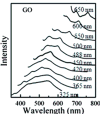Fluorescence and Sensing Applications of Graphene Oxide and Graphene Quantum Dots: A Review
- PMID: 28742956
- PMCID: PMC5915373
- DOI: 10.1002/asia.201700814
Fluorescence and Sensing Applications of Graphene Oxide and Graphene Quantum Dots: A Review
Abstract
Graphene oxide and graphene quantum dots are attractive fluorophores that are inexpensive, nontoxic, photostable, water-soluble, biocompatible, and environmentally friendly. They find extensive applications in fluorescent biosensors and chemosensors, in which they serve as either fluorophores or quenchers. As fluorophores, they display tunable photoluminescence emission and the "giant red-edge effect". As quenchers, they exhibit a remarkable quenching efficiency through either electron transfer or Förster resonance energy transfer (FRET) process. In this review, the origin of fluorescence and the mechanism of excitation wavelength-dependent fluorescence of graphene oxide and graphene quantum dots are discussed. Sensor design strategies based on graphene oxide and graphene quantum dots are presented. The applications of these sensors in health care, the environment, agriculture, and food safety are highlighted.
Keywords: biosensors; fluorescence; graphene; quantum dots; sensors.
© 2017 Wiley-VCH Verlag GmbH & Co. KGaA, Weinheim.
Conflict of interest statement
The authors declare no conflict of interest.
Figures











Similar articles
-
Recent progress on graphene quantum dots-based fluorescence sensors for food safety and quality assessment applications.Compr Rev Food Sci Food Saf. 2021 Nov;20(6):5765-5801. doi: 10.1111/1541-4337.12834. Epub 2021 Oct 2. Compr Rev Food Sci Food Saf. 2021. PMID: 34601802 Review.
-
Origin of strong excitation wavelength dependent fluorescence of graphene oxide.ACS Nano. 2014 Jan 28;8(1):1002-13. doi: 10.1021/nn405843d. Epub 2013 Dec 26. ACS Nano. 2014. PMID: 24359152
-
Biocompatible Fluorescent Graphene Oxide Quantum Dots for Imaging of Drosophila melanogaster.ACS Omega. 2024 Aug 30;9(37):38916-38924. doi: 10.1021/acsomega.4c05244. eCollection 2024 Sep 17. ACS Omega. 2024. PMID: 39310168 Free PMC article.
-
Mechanism for excitation-dependent photoluminescence from graphene quantum dots and other graphene oxide derivates: consensus, debates and challenges.Nanoscale. 2016 Apr 21;8(15):7794-807. doi: 10.1039/c6nr00605a. Nanoscale. 2016. PMID: 27030656 Review.
-
Biosensing with Förster Resonance Energy Transfer Coupling between Fluorophores and Nanocarbon Allotropes.Sensors (Basel). 2015 Jun 23;15(6):14766-87. doi: 10.3390/s150614766. Sensors (Basel). 2015. PMID: 26110411 Free PMC article. Review.
Cited by
-
Tris-(2-aminoethyl)amine-Intercalated Graphene Oxide as an Efficient 2D Material for Cerium-Ion Fluorescent Sensor Applications.ACS Omega. 2019 Dec 16;4(27):22431-22437. doi: 10.1021/acsomega.9b03089. eCollection 2019 Dec 31. ACS Omega. 2019. PMID: 31909325 Free PMC article.
-
Graphene Oxide as a Multifunctional Platform for Intracellular Delivery, Imaging, and Cancer Sensing.Sci Rep. 2019 Jan 23;9(1):416. doi: 10.1038/s41598-018-36617-4. Sci Rep. 2019. PMID: 30674914 Free PMC article.
-
A "turn-off" photoluminescent sensor for H2O2 detection based on a zinc oxide-graphene quantum dot (ZnO-GQD) nanocomposite and the role of amine in the development of GQD.RSC Adv. 2023 Jul 19;13(32):21808-21819. doi: 10.1039/d3ra02355a. eCollection 2023 Jul 19. RSC Adv. 2023. PMID: 37475761 Free PMC article.
-
Single-Walled Carbon Nanotubes as Optical Transducers for Nanobiosensors In Vivo.ACS Nano. 2024 Dec 31;18(52):35164-35181. doi: 10.1021/acsnano.4c13076. Epub 2024 Dec 18. ACS Nano. 2024. PMID: 39696968 Free PMC article. Review.
-
Graphene-like emerging 2D materials: recent progress, challenges and future outlook.RSC Adv. 2023 Nov 13;13(47):33336-33375. doi: 10.1039/d3ra04456d. eCollection 2023 Nov 7. RSC Adv. 2023. PMID: 37964903 Free PMC article. Review.
References
-
- Huang HM, Li ZB, She JC, Wang WL. J Appl Phys. 2012;111:054317.
- Mathkar A, Tozier D, Cox P, Ong PJ, Galande C, Balakrishnan K, Reddy ALM, Ajayan PM. J Phys Chem Lett. 2012;3:986–991. - PubMed
-
- Zhu SJ, Zhang JH, Qiao CY, Tang SJ, Li YF, Yuan WJ, Li B, Tian L, Liu F, Hu R, Gao HN, Wei HT, Zhang H, Sun HC, Yang B. Chem Commun. 2011;47:6858–6860. - PubMed
Publication types
Grants and funding
LinkOut - more resources
Full Text Sources
Other Literature Sources
Research Materials

